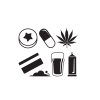Ketamine Guide for Drug Workers
Engaging with problem Ketamine users
This Ketamine guide for drug workers has been prompted by a number of requests from drugs workers for more detailed information on engaging with ketamine users who are experiencing problems but do not fit the traditional ‘problem drug user’ (i.e. heroin) profile and who wish to provide practical, effective interventions.
The use of ketamine has been on the increase in the past few years, particularly on the gay clubbing scene. Although not included in the British Crime Survey (BCS) until 2006/7, when it was made illegal, the proportion of 16-24 year-olds reporting using it ever in their lifetime has gone from 1.3% in 2006 to 2% in 2009/10. Although this may not sound a lot in statistical terms, it equates to around 113,000 persons having used it at some time.
Although most use it for recreational purposes (occasionally, in the context of a night out clubbing) with few problems, anecdotal evidence from outreach workers in several areas is emerging which does give cause for concern. Some ketamine users have developed more chaotic, daily, even dependent patterns of consumption with a range of negative and unwanted side-effects.
What is ketamine?
Ketamine is an anaesthetic drug with dissociative properties. First developed in the1960s, it was routinely used in surgery up until the 1980s. Because of its speed of action and safety (unlike traditional anaesthetics it does not affect breathing) it was recommended for use on the very young and the elderly.
Ketamine in crystal form, produced by evaporation or 'cooking' liquid Ketamine
Ketamine seems to have the unusual capacity to disconnect the physical being from the psychic self, which some describe as an ‘out-of-body’ experience. This was often interpreted as a near-death experience, although patients were in no physical danger as overdose is very rare. Because of this, ketamine is more commonly used in severe trauma cases, such as burns or traffic accidents.
Although ketamine is not used as a primary anaesthetic in humans it is more widely used in veterinary surgery, which is probably where the popular ‘horse tranquilliser’ misnomer has arisen. As a marketing ploy, something that could knock out a horse sounds like a winner for dealers. Even though it is mainly used on a wide range of small animals, ‘hamster tranquilliser’ just doesn’t have the same ring to it.
Ketamine image
Ketamine in liquid form
The non-medical use of ketamine became popular in the UK in the early 1990s rave scene, often sold in tablet form as ecstasy. These days ketamine is usually sold as ketamine and comes as a white powder which can be snorted (most common), swallowed (less common as it takes too long to work and acts as a laxative!), smoked (rare, as it tastes awful and wears off too quickly) or injected (very rare and not recommended).
When snorted, the effects begin within a few minutes and last around 30-45 minutes, depending on how much is taken. A common method in a club would be to dip the end of a key into the bag of powder and sniff a small amount (around 200mg) from the tip, known as ‘keying’. This short duration of action leads to re-dosing at regular intervals throughout the night. If swallowed, the effects begin around 15-30 minutes and last for 1-3 hours.
What are the effects of ketamine?
Despite what many users feel, ketamine is not a depressant-type drug and does not slow the heart. In fact, at anaesthetic doses it is a powerful stimulant that increases heart rate. However, at low doses the subjective effects of ketamine are experienced as a slowing down and heaviness of the body, what used to be known as ‘sledging’.
Sought after mental effects include a trance-like state, disconnection from the reality, feelings of floating or flying, and visual (sometimes shared) hallucinations. The ketamine experience is very dependent on the environment within which it is taken. Taken at low doses in a club or rave where there is loud music, lighting effects and the buzz of the crowd, it can be stimulating with increased energy and euphoria.
Consumed in a quiet, relaxed setting, at home with friends, users say it can provide a transcendental, spiritual experience, with apparent travel to other worlds and places (the ‘out-of-body’ experience), a welling up of long-forgotten (or suppressed) memories, apparent insight into the nature of existence, distortion of time, and the belief that one has died and been re-born. There can also be panic and very unpleasant feelings and nightmare-like experiences.
Physical effects can include loss of control over the body, loss of coordination, difficulty speaking, moving, hearing and seeing (delirium), numbness, and nausea. Ketamine has been described as ‘psychedelic heroin’ and ‘L.A. coke’, emphasising the mixed and complex nature of the effects.
Short-term side-effects of Ketamine
Increase in heart rate
Slurred speech
Confusion, disorientation
Out-of-body experience
Shifts in perception of reality
Nausea
Sedation
Cardiovascular effects, including hypertension and tachycardia
Respiratory depression
Hypersalivation
Pleasant mental and/or body high
Increase in energy
Euphoria
Sense of calm and serenity
Meaningful spiritual experiences
Enhanced sense of connection with the world (beings or objects)
Distortion or loss of sensory perceptions (common)
Open- and closed-eye visual hallucinations (common)
Dissociation of mind from body
Analgesia, numbness
Ataxia (loss of motor coordination)
Significant change in perception of time
What are the problems?
The main problem associated with ketamine is physical helplessness as disconnection from the body can be dangerous, especially in the disorienting environment of a club or rave. This is similar, in many ways, to being extremely drunk in a public place where accidents are more likely. This can leave the user vulnerable to assault (both physical and sexual) and having unprotected sex, increasing the risk of unplanned pregnancy, sexually transmitted infections (STIs) like gonorrhoea, and blood-borne viruses (BBVs) such as hepatitis and HIV.
Fatal overdose is extremely rare as the upper limit for safe use in medicine is very high. What is more likely is that the user would pass out before reaching a fatal dose, which is dangerous in itself. Unconsciousness is an emergency situation and should be treated as such.
Ketamine in tablet form
Nowadays, very few people use one drug on its own, and ketamine is no exception. Ketamine is often used, on a night out, in combination with a range of substances including alcohol (avoid!), cocaine (CK1), and the plethora of new and emerging compounds (“legal highs”) that are becoming more readily available. Obviously, mixing drugs increases the risks and should be avoided as the outcome is difficult to predict.
Although not considered physically addictive, tolerance to ketamine builds up very quickly and higher doses are needed to achieve the desired effects. As mentioned earlier, some users are getting into patterns of compulsive binges. This can lead to problems with memory, word/name recall, reduced attention span, damage to relationships, loss of productivity, isolation, and neglecting other interests. Despite evidence of harm the compulsive user often finds it difficult to cut down, all the hallmarks of dependence.
Occasional use of ketamine (once or twice a month) is not thought to cause any long-term or irreversible damage. Persistent use, however, has been linked with a wide range of distressing psychological effects, including anxiety, panic attacks, flashbacks, post-traumatic stress disorder, persistent perceptual changes, mania, depression, suicidal thoughts, insomnia, nightmares, night terrors, an unpleasant feeling of being unreal or that the world is unreal, paranoia, grandiose delusions, and fragmentation of the personality.
There is evidence of some physical damage caused by excessive use, particularly to the bladder and urinary tract. One study linked urinary tract disease with ketamine as users reported a range of symptoms associated with ulcerative cystitis, including an increased need to urinate, passing blood in urine, leakage of urine and pain on urination. It is thought that these may be associated with scarring and shrinking of the bladder which, if use continues, could go on to cause irreversible damage and harm the kidneys.
Another, more commonly reported symptom is K-pains or K-cramps. The cause of these abdominal pains are, as yet, unclear, but seem to be linked to high dose use of more than a gram a day.
Ketamine is illegal. Under the Misuse of Drugs Act (1971) it is a Class C drug. The maximum penalty for possession is two years in jail plus an unlimited fine. The maximum penalty for supplying to another person (dealing or giving away) is 14 years imprisonment plus an unlimited fine.
How you can help
The law
Let’s take that last point first. Ketamine is illegal. If the client wants to avoid the risk of arrest, prosecution, fine, jail or a criminal record – don’t go near ketamine. Simple. All ketamine users should be made aware of the legal risks they run.
Engagement
It is quite likely that mainstream drug services will not see ketamine users presenting for help. This is due, in part, to services being set up to deal with other drugs and are not geared towards the needs of ketamine users. This will also be the perception of ketamine users who don’t see themselves in the same league as heroin or crack users and may feel unwilling to attend such a service.
Contact is more likely to be made through advertising, in the appropriate places, your agency as a more broad-based service, ready and willing to support all forms of drug user. It is not the drug that is important but the behaviour. If you can get this across you may attract a more diverse clientele.
Even more effective will be outreach workers who can get to know ketamine users on their own terms. This approach has proved effective in many areas and helps to provide a bridge into mainstream provision. Outreach workers can also act as an early warning system, picking up on new trends developing in the community before individuals arrive on your doorstep needing help.
If you don’t currently have an outreach team, get one.
Education
Making ketamine users aware of the potential risks, particularly when mixed with other drugs, and ways of reducing harm is vital. How this information is put across will also determine the uptake of the service. Unrealistic, scaremongering will put people off, whereas honest, non-sensational, culturally attuned awareness raising will engage more effectively.
But, to be effective, it’s the credibility of the sender rather than the message itself that is often more important. If your agency has a user-friendly, non-punitive reputation in the community then individuals will feel more comfortable about coming forward. This is where outreach, again, can prove useful. Outreach workers can gain the trust of clients and explain what your service has to offer, as well as providing advice and information at the point of contact.
Vulnerability
Friends shouldn’t need reminding that, on a night out, they must look after each other. Even so, it’s worth reinforcing the message that if someone is really out of it they are vulnerable to all kinds of danger.
So make a plan before going out – stick together, agree meeting places if you get separated, before you go out order a taxi to pick you all up afterwards, make sure everyone has got each other’s phone numbers, try to keep tabs on who has taken what and how much. If someone is really out of it they should never be left alone or put in a taxi to be taken home on their own. They may not be in a fit state to make rational decisions, so they should not go off with their new ‘best friends’.
This may sound improbable, and boring, but if it’s not discussed no-one will think about it.
Collapse and unconsciousness
All drug users need to know how to react if someone collapses and this is important knowledge that you can pass on. Because of the ‘sledging’ effects of ketamine, this may prove very important.
Simple First Aid techniques (recovery position, stay with them + call an ambulance), applied at the point of need, saves a lot of bother. If you don’t currently teach First Aid to your clients, see about setting something up.
The Recovery Position
Compulsive use
Remember, it’s the behaviour not the drug. Clients who feel they can’t control their ketamine use are no different from the alcohol or heroin user who feels they can’t control their use either. An experienced worker will know where to use a brief intervention, how to assess need, or when to suggest more in-depth interventions such as CBT or MI.
Brief interventions, such as quantifying consumption, exploring the pros and cons of using or keeping a diary of use, has been shown to be very effective in reducing alcohol consumption. It has been used successfully with other drugs, so why not ketamine. Helping a client to define their frequency and level of use, and the gains to be made by cutting down, can help to break up patterns of consumption.
Cognitive Behavioural Therapy (CBT) has been used successfully in helping clients understand their motivation to use other drugs and could be equally applied to ketamine. Understanding how patterns of behaviour develop, identifying cues and triggers that stimulate the desire to use, and devising strategies to cope with high-risk situations can all help to bring about change.
And change is the goal. If a client is concerned enough about some aspects of their ketamine use, a Motivational Interviewing (MI) approach can help to identify how change can be incorporated into behaviour. Maintaining that change over time will help move the client through the process and into a less harmful situation.
Mental health
Ketamine has profound psychological effects. It can take the user to some very strange places inside their own head. If they do have unpleasant or suppressed memories, or do have an underlying or overt mental health issue then ketamine could exacerbate these. If the client does have a bad experience they should stop using ketamine immediately. If something has come to the surface that won’t go away, they should seek help from their GP.
Most people who have a bad, transitory ketamine experience will return to normal and will have learned an important lesson - Ketamine is an interesting place to visit, but you wouldn’t want to live there. For many, this will help them re-evaluate the desire for a trip to the dark side and possibly deter them in future.
Physical health
Most of the physical problems associated with ketamine are due to accidents whilst under the influence. At high doses, a numbness in the extremities (mainly fingers and toes) is not unusual, but this might mask a broken bone that does not become apparent until the ketamine wears off. Looking after each other when on a night out is good advice, but if everyone’s in the K-hole it’s not much use. In the event of an accident or fall, making others (bar staff, security, First Aiders, etc.) aware that ketamine has been used could help avoid major injuries going unnoticed.
As stated above, some heavy users of ketamine have developed bladder problems. If any of the symptoms outlined above are experienced, it makes good sense to stop using ketamine altogether and seek medical advice. As for K-cramps, even though the exact cause is unclear it has been suggested that Tyrosine, used only under medical supervision, can help alleviate the pain.
The bottom line is this – If you want to avoid harm don’t do ketamine.
Further Information For further Information on Cognitive-Behavioural Therapy (CBT) click here
For further Information on Motivational Interviewing (MI) click
here
Training for substance misuse workers and organisations. More
To browse Ketamine publications go to the Substance Shop.












